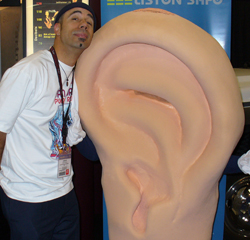
Liability Issues
While most professional touring sound companies do not report statistics regarding hearing loss of employees, given the increasing incidence of litigation from audience members at concerts where sound levels have been extremely high, it may become important for such companies to pay increased attention to the requirements of other industries where reporting audiometric data is commonplace.
In 2004, OSHA put into effect a new rule applicable to employers who record and report hearing loss of their employees. New requirements include use of a “two-step criterion for determining when to report recordability of hearing losses.”
Work-related hearing losses must be reported to OSHA when:
1) There has been a “standard threshold shift”, defined as an average shift in hearing threshold of 10 dB or greater at 2 kHz, 3 kHz, and 4 kHz, relative to the audiometric baseline (formerly 25 dB);
2) The average hearing level in the same ear is 25 dB or greater at 2 kHz, 3 kHz and 4 kHz.
OSHA hopes that implementation of these rules will causes employers to become more aware of noise exposure as an occupational hazard, and therefore more motivated to provide improved hearing conservation and noise control programs.
Audio professionals might consider incorporating these guidelines into their own private record keeping of employee audiometric data.
OSHA will also begin recording and tracking hearing loss on the “OSHA 300 Log of Workplace Injuries and Illnesses.” This means that accurate statistics regarding hearing loss will now be monitored by a central agency, and employers will be able to quantify work-related hearing loss in addition to other injuries acquired on the job.
According to author Claire Bernstein: “For audiologists, this represents a dramatic advance and is expected to have a major impact on tracking the real incidence of work-related hearing loss. Driven by financial considerations, most employers rely on hearing protection in lieu of noise control.
With these statistics OSHA will now have more thorough tracking information so it can better direct research, training, and enforcement activities.”
Since listening is our life’s work, and exposure to loud sound is part of the job, it’s important to take preventative steps, rather than attempt to eradicate loud sound altogether, in an effort to care for our ears.
There are several easy things you can do to improve your hearing health.
• Monitor both the intensity level and duration of exposure. If the duration of exposure will be long, try to limit the intensity level. Conversely, louder levels may be acceptable, but for a shorter duration of exposure.
• Pay attention to your physical relationship to other sound sources. Standing directly in the path of the sound source can cause greater levels of exposure, compared to enclosing or baffling a sound source or standing at an angle from the source.
• After exposure, give your ears a rest. Take at least an hour to sit somewhere quiet. If your session runs long, take frequent breaks.
• Be aware of exposure to non-musical, “recreational” noises like loud television or driving with the windows open at high speeds. If possible, use hearing protective devices when environmental noises seem excessive.
